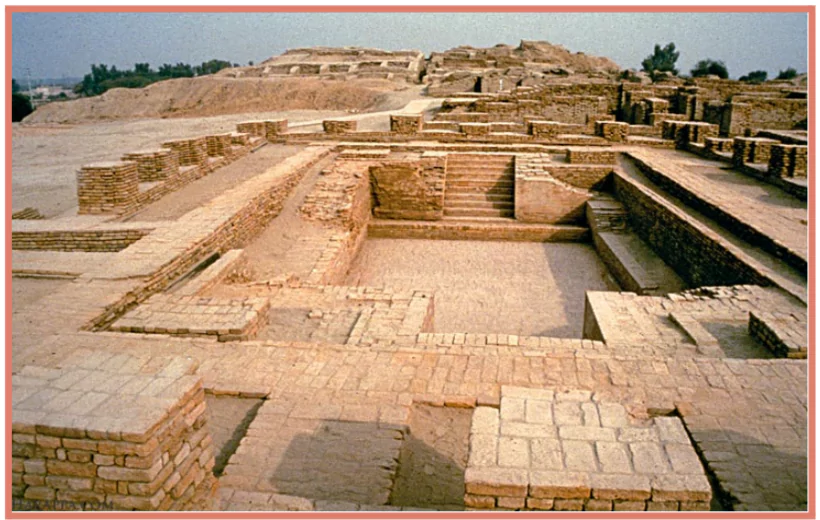Archaeologists discovered traces of a water storage area between mounds one and two in Rakhigarhi village, Hisar district, Haryana.
- The structure, with a depth of 3.5 to 4 feet, highlights advanced water management practices by the Harappan civilisation.
Key highlights of Discovery
- Elite Habitation Zone:
- Mounds one, two, and three have been identified as an elite zone, containing massive structures indicating habitation by the upper class of the Harappan society.
- River Dependency:
- Evidence points to the now-extinct Chautang (Drishavati) river, located 300 meters from the site, as a vital water source for the ancient city.
- Code drilling and findings from the Zoological Survey of India confirm the presence of the Chautang riverbed near mound seven.
- The Drishavati river’s drying up, along with the Sarasvati river, likely triggered water crises that could contribute to the decline of the Harappan civilisation.
Enroll now for UPSC Online Course
Water Management Techniques of Harrapan Civilization
1. Urban Water Supply and Drainage Systems
- Well-Planned Drainage Networks:
- Cities like Mohenjo-Daro and Harappa had sophisticated underground drainage systems.
- Drains were covered with bricks and connected to bathing platforms in homes.
- Wastewater was directed into soak pits, preventing contamination of living areas.
- Examples:
- Mohenjo-Daro: Brick-lined drains ran along streets, with inspection holes for maintenance.
- Dholavira: Large interconnected drains channeled water from residential and public areas.

2. Water Storage Reservoirs
- Reservoirs and Tanks:
- Large water tanks were constructed for communal use, religious purposes, or water conservation.
- Example:
- Dholavira (Gujarat): The city featured stepwells and massive reservoirs built to store rainwater and channel runoff, especially during the monsoon season.
- Lothal (Gujarat): A dockyard with provisions for water storage, likely for trade-related purposes.
3. Wells
- Private and Public Wells:
- Wells were a common feature in Harappan cities, ensuring a steady supply of water for drinking and domestic use.
- Examples:
- Mohenjo-Daro: Over 700 wells identified, often located close to houses.
4. Canals and Irrigation
- Canal Systems for Agriculture:
- Harappans constructed canals to divert river water for irrigation.
- Channels were designed to ensure controlled water flow, vital for crop cultivation.
- Example:
- The Ghaggar-Hakra system: Likely utilized for irrigation, though evidence is indirect.
5. Rainwater Harvesting
- Collection of Rainwater:
- Structures were designed to maximize rainwater collection and storage.
- Example:
- Dholavira: Sophisticated rainwater harvesting systems incorporated channels and reservoirs to capture and store water efficiently.
Check Out UPSC CSE Books From PW Store
6. Adaptation to River Systems
- Dependency on Rivers:
- The Harappans relied on rivers like the Indus, Sarasvati, and Drishavati for water resources.
- Evidence suggests they stored water during peak flow seasons for later use.
- Examples:
- Rakhigarhi: Evidence of water storage linked to the Drishavati river.
- Kalibangan: Remnants of a riverbank settlement with signs of water collection.
7. Sanitation and Wastewater Management
- Integrated Sanitation Systems:
- Harappans prioritized hygiene with separate drains for waste disposal and bathing.
- Households were equipped with soak jars or cesspits to prevent clogs in public drains.
- Example:
- Mohenjo-Daro: Houses often had bathrooms connected to street drains.
About Rakhigarhi
- Rakhigarhi is located in the Hisar district of Haryana, approximately 27 km from the Ghaggar river in the Ghaggar-Hakra river plain.
- One of the oldest and largest cities of the Indus Valley Civilization (Harappan Civilization), dating back to 6500 BCE.
Key Findings

- Archaeological Mounds:
- Seven mounds have been identified at Rakhigarhi, covering an area of around 350 hectares.
- The site shows evidence of habitation during the Early Harappan (Pre-Urban) and Mature Harappan (Urban) phases.
- Urban Planning:
- Bronze Age Urbanism:\
- Provides insights into early urban planning, social organization.
- Mud-brick and burnt-brick houses.
- A sophisticated drainage system indicating advanced urban infrastructure.
- Artifacts:
- Ceramic Industry:
- Pottery including red ware, dish-on-stand, vase, jar, bowl, goblet, and perforated jars.
- Sacrificial Pits:
- Mud-brick-lined pits with triangular and circular fire altars, pointing to ritualistic practices.
- Seals:
- A cylindrical seal featuring five Harappan characters and an alligator symbol is notable.
- Other Antiquities:
- Terracotta and shell bangles, beads of semi-precious stones, copper objects, and animal figurines.
- Toy cart frames and terracotta wheels.
- Blades, bone points, and inscribed steatite seals.
Enroll now for UPSC Online Classes
Cultural and Historical Insights
- Early and Mature Harappan Phases:
- Early Harappan: Evidence of settlement and early urban planning.
- Mature Harappan: Well-planned cityscape, trade, and specialized craftsmanship.
- Late Harappan: The site was abandoned, reflecting broader trends of decline in the Indus Valley Civilization.
- Ritualistic Practices:
- Animal sacrificial pits and fire altars suggest a complex ritual and religious system.
- Craft and Trade:
- Artifacts like terracotta bangles, beads, seals, and pottery point to skilled craftsmanship and an active trade network.
![]() 28 Dec 2024
28 Dec 2024



